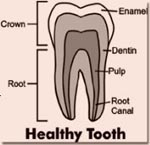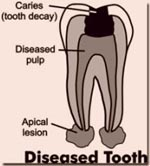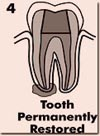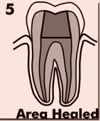Root Canal Treatment
What is root canal treatment?
Root canal treatment, also known as endodontic treatment, is a dental procedure in which the diseased or damaged pulp (core) of a tooth is removed and the inside areas (the pulp chamber and root canals) are filled and sealed.
Why do I need it?
The pulp, or soft inner tissue of your tooth, is normally surrounded and protected by a layer of dentin. Above the gumline, a layer of enamel protects the dentin; below the gumline, the dentin is covered by cementum. When a deep cavity, decay or crack destroys these protective layers, the pulp is exposed to the bacteria in your mouth. This can result in inflammation, infection and, eventually, necrosis (pulp death). A severe blow to the tooth can also damage the pulp. Irritants may then escape from the end of the root and cause a diseased area (apical lesion) in the bone. Pus accumulates at the ends of the roots, forming a painful abscess (Pus filled cavity usually seen in this condition in side the mouth), which can damage the bone supporting the teeth. Such an infection may produce pain that is severe, constant, or throbbing, as well as prolonged sensitivity to heat or cold, swelling and tenderness in the surrounding gums, facial swelling, and discoloration of the tooth. However, in some cases, the pulp may die so gradually that there is little noticeable pain.
Root canal treatment removes the damaged pulp and irritants. This allows the bone surrounding the root end to repair and heal.


Common signs of pulp problems include:
- Pain when biting down on a tooth
- Sensitivity to hot or cold food or beverages
- Tooth discoloration
- Swollen gums around the infected tooth
Couldn't I just have the tooth removed?
You could get it removed, but then adjoining teeth may shift and interfere with biting and chewing. You can have a replacement tooth implanted or attached to adjacent healthy teeth, but this can be expensive and require even more dental treatment. There is no real substitute for your own natural tooth, which is more efficient in chewing and biting than an artificial one.
What happens during root canal treatment?
An examination, including X-rays, will be performed. A local anesthetic will be given, if necessary. A sheet of rubber latex, called a "rubber dam," will/may be placed around the tooth to isolate it and keep it clean and dry during treatment.
Complete root canal treatment usually consists of the following five basic steps:
 Step 1. An opening is made in the crown of the tooth. Creating this access also relieves the pressure inside the tooth and can dramatically ease pain.
Step 1. An opening is made in the crown of the tooth. Creating this access also relieves the pressure inside the tooth and can dramatically ease pain.
 Step 2. The pulp is removed from the pulp chamber and root canals. The dentist determines the length of the root canals, usually with a series of X-rays. Tiny instruments ("files") are used to clean the root canals and shape them to a form that will ensure they will be well sealed. A temporary filling is placed in the opening to seal the opening and protect the tooth between appointments.
Step 2. The pulp is removed from the pulp chamber and root canals. The dentist determines the length of the root canals, usually with a series of X-rays. Tiny instruments ("files") are used to clean the root canals and shape them to a form that will ensure they will be well sealed. A temporary filling is placed in the opening to seal the opening and protect the tooth between appointments.
 Step 3. The root canals are filled and sealed with a material that prevents bacteria from re-entering. The opening in the crown of the tooth is sealed with a temporary filling. Radiographs (X-rays) are made before, during and after treatment.
Step 3. The root canals are filled and sealed with a material that prevents bacteria from re-entering. The opening in the crown of the tooth is sealed with a temporary filling. Radiographs (X-rays) are made before, during and after treatment.
 Step 4. At the next appointment, the temporary filling will be replaced with a permanent filling and then with a ceramic / porcelain crown.
Step 4. At the next appointment, the temporary filling will be replaced with a permanent filling and then with a ceramic / porcelain crown.
Root canal treatment is not complete without the placement of a crown.
 Step 5. The root canal, permanent filling, and/or crown are evaluated for healing at periodic intervals called recall appointments.
Step 5. The root canal, permanent filling, and/or crown are evaluated for healing at periodic intervals called recall appointments.
Is this procedure going to hurt?
With modern techniques and anesthetics people report that having a root canal treatment is about as painless as having a cavity filled. Should you experience any discomfort, call your dentist, who will do everything possible to make you comfortable.
What care should be taken after the root canal treatment?
The tooth may be sore or you may experience pain/discomfort for several days after the filling. Pain relievers, may be taken to ease the soreness as prescribed by the dentist. The tissues around the tooth may also be irritated. Rinsing the mouth with warm salt water several times a day will help. Chewing on that side of the mouth may need to be avoided for the first few days following treatment. A follow-up appointment should be scheduled with the dentist for six months after treatment to make sure the tooth and surrounding structures are healthy.
How long will my teeth last after this treatment?
Although the pulp is removed, your tooth remains alive, nourished by surrounding bone and gum tissues. With a permanent restoration (crown), regular brushing and flossing, proper diet and periodic dental checkups, your tooth has an excellent chance for success.
What you need to know after a Root Canal treatment:
- Soreness
- Pain
- Permanent Filling
Most patients experience a little soreness after the appointment. This may be due to the injection, the necessity of keeping the mouth open for a long time, or the treatment. Your temporary filling will be hard enough to bite on within approximately a half-hour, but avoid biting or chewing on the treated tooth if it hurts.
Over-the-counter pain relievers usually relieve the discomfort. Should pain last more than a few days, or if severe pain or swelling occur, call your dentist. Remember, if your tooth hurt before you came in for treatment, it may take a while to heal.
When your root canal treatment is complete, a temporary filling is placed. The tooth needs to be permanently restored to prevent contamination or fracture, so you will need to return for a permanent restoration. It is important to return promptly because the temporary filling can loosen and leak, possibly causing the root canal treatment to fail, which would necessitate re-treatment.
Myths About Root Canal Treatment
There are many misconceptions surrounding root canal (endodontic) treatment. As always, when considering any medical procedure, you should get as much information as you can about all of your options. Your dentist or endodontist can answer many of your questions.
Myth #1: Root Canal treatment is Painful
Truth—Root canal treatment doesn't cause pain, it relieves it.Most patients see their dentist or endodontist when they have a severe toothache. Damaged tissues in the tooth can cause the toothache. Root canal treatment removes this damaged tissue from the tooth, thereby relieving the pain you that you feel.
The perception of root canals being painful began decades ago when root canal treatment was painful. But with the latest technologies and anesthetics, root canal treatment today is as easy / comfortable like having a filling placed. In fact, a recent survey showed that patients who have experienced root canal treatment are six times more likely to describe it as "painless" than patients who have not had root canal treatment.
Myth #2 : Root canal Treatment Causes Illness (Fever)
Truth—Root canal treatment is a safe and effective procedure.
Research conducted over the years showed no relationship between root canal treated teeth and the presence of illness(Fever). Instead, researchers found that people with root canal fillings were no more likely to be ill than people without them.
The presence of bacteria in teeth and mouth has been an accepted fact for many years. But presence of bacteria does not necessarily mean there should be "infection" and is not necessarily a threat to a person's health. Bacteria are present in the mouth and teeth at all times, even in teeth that have never had a cavity or other trauma.
One of the causes for illness in earlier days may be due to improper sterilization procedures. But in modern day dentistry today sterilization if all instruments is of utmost priority which has almost totally eradicated the event of causing illness.
It is now well known that teeth that receive proper root canal treatment do not cause illness.
Myth #3—A good alternative to root canal treatment is extraction (pulling out the tooth).
Truth—Saving your natural teeth, if possible, is the very best option.
Nothing can completely replace your natural tooth. An artificial tooth can sometimes cause you to avoid certain foods. Keeping your own teeth is important so that you can continue to enjoy the wide variety of foods necessary to maintain the proper nutrient balance in your diet.
Root Canal treatment, along with appropriate permanent restoration (cap or crown), is a cost-effective way to treat teeth with damaged pulp and is usually less expensive than extraction and placement of a bridge or an implant.
Root Canal treatment also has a very high success rate. Many root canal treated teeth last a lifetime.
Placement of a bridge or an implant will require significantly more time in treatment and may result in further procedures to adjacent teeth and supporting tissues.
Millions of properly root canal treated teeth serve patients all over the world, for years and years after treatment. Those healthy teeth are helping patients chew efficiently, maintain the natural appearance of their smiles and enhance their enjoyment of life. Through root canal treatment, Endodontists and dentists worldwide enable patients to keep their natural teeth for a lifetime.